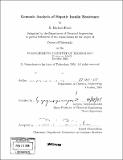Genomic analysis of hepatic insulin resistance
Author(s)
Raab, R. Michael
DownloadFull printable version (16.83Mb)
Other Contributors
Massachusetts Institute of Technology. Dept. of Chemical Engineering.
Advisor
Gregory Stephanopoulos.
Terms of use
Metadata
Show full item recordAbstract
Type II Diabetes mellitus is a genetically complex disease characterized by insulin resistance in peripheral tissues, which results in simultaneous hyperglycemia and hyperinsulinemia. Because of the prevalence of type II diabetes, many researchers are investigating the genetics of glucose homeostasis, however, traditional mapping techniques have not been successful in determining all of the genes that regulate glycemia. To complement these efforts, we used DNA microarrays to find differentially expressed genes and combinatorial siRNA screening to investigate the effects of hepatic gene transcription during periods of high and low glucose production. This strategy provides a new approach to studying the molecular mechanisms of disease pathogenesis. Our investigations focused on discovering new genes that influence hepatic metabolism and glucose production. Hepatocytes help maintain whole body glycemia by providing glucose and other substrates during non-feeding periods. DNA microarrays containing 17,000 unique gene probes were used to study hepatic gene transcription during normal, insulin resistant, and fasting states in C57/BL/6J mice. We analyzed this data set using a combination of statistical and multivariate techniques to determine 41 different, genes that are differentially expressed and highly discriminatory of the treatment groups. (cont.) Hepatocytes perform many physiological roles, thus to investigate which genes from the microarray analysis affected hepatic metabolism, we developed combinatorial RNA-interference (RNAi) based gene silencing techniques. Using combinatorial siRNA screening, we silenced genes that were over-expressed within the microarray data set to study loss of function effects on hepatic metabolism, which was quantified by measuring intracellular metabolite concentrations in relevant metabolic pathways. Based upon the metabolite dependent clustering of experimental and control samples using Fisher Discriminant Analysis, four of the silenced genes had a significant effect on key metabolites involved in hepatic glucose output. Of these four genes, three were shown to influence hepatic glucose output in our primary cell model.
Description
Thesis (Ph. D.)--Massachusetts Institute of Technology, Dept. of Chemical Engineering, February 2006. Includes bibliographical references (leaves 159-191).
Date issued
2006Department
Massachusetts Institute of Technology. Department of Chemical EngineeringPublisher
Massachusetts Institute of Technology
Keywords
Chemical Engineering.